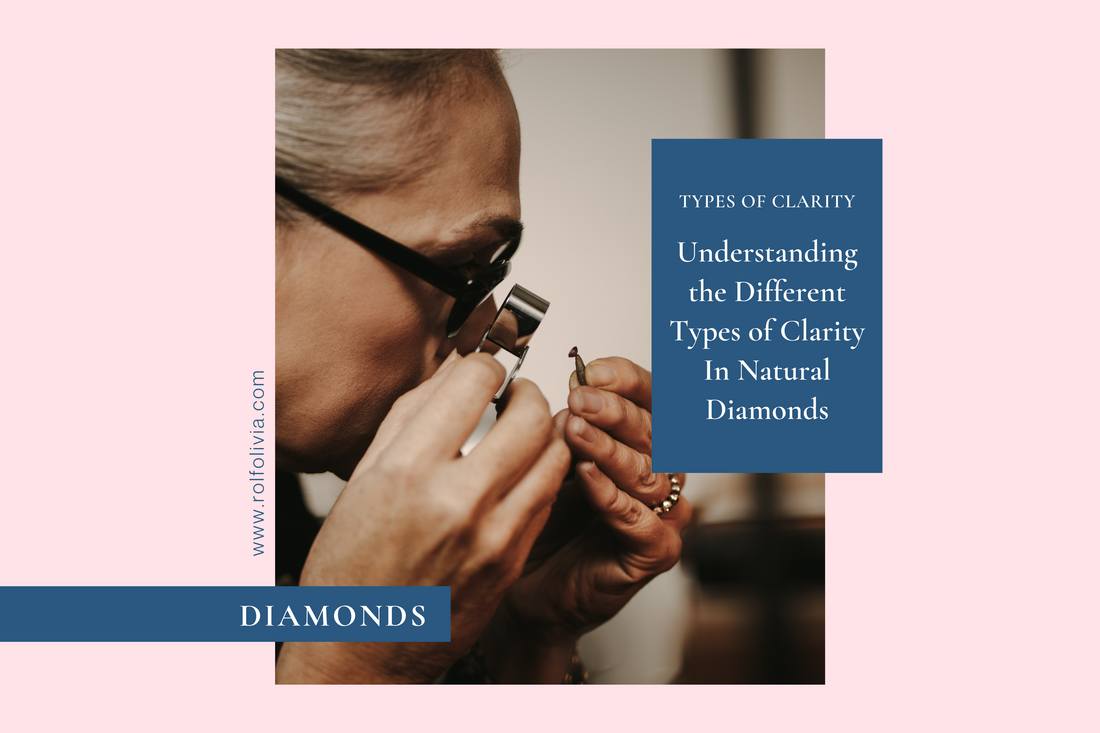Shop Affordable Diamond Jewelry at Rolf & Olivia
Are you confused by all the different clarity grading standards out there? Well, you’re not alone! Natural diamonds can be challenging to understand because of their complexity. They are created in the earth over a long period of time, and each diamond has its own unique properties. It’s important to educate yourself on your options when looking for that special something with an fascinating history. Natural diamonds come in a variety of colors (blue, yellow, brown, green) and clarity levels (fancy brilliant being the highest). Understanding these factors is key to getting the best natural diamond for your budget and personal taste. This blog will explore all the different types of clarity and what they mean for you as a buyer.
What Is Diamond Clarity?
Clarity refers to the overall quality of a diamond’s transparency and appearance. There are 10 different clarity grading standards used in the diamond industry. The most commonly used clarity grading standards are FL (fancy light), VS (very slightly included), and SI (selectively included). These clarity standards are based on defects (inclusions) and blemishes (flaws) found in natural diamonds. Inclusions are things like mineral deposits, growth lines, and other areas where a diamond was less dense during formation. These are natural defects that occur during the diamond’s formation. They don’t affect the brilliance or quality of a diamond, but they are what determine the diamond’s clarity grading. A diamond’s clarity grading is based on how noticeable these inclusions are. The less noticeable an inclusion is, the higher the clarity grading will be. While a diamond’s clarity grading is important, it’s also important to note that inclusions have little effect on a diamond’s sparkle. Diamonds are graded on their appearance, not their brilliance. So, even a diamond with a lower clarity grading will look just as brilliant as a higher clarity diamond.
Why Does Clarity Matter When Buying Natural Diamonds?
The diamond you choose will be one of the most important decisions you make on your wedding day. Diamonds are a timeless symbol of love and commitment, and they come in an array of colors and sizes to suit anyone’s taste and budget. Natural diamonds also come with unique histories and stories. By purchasing a natural diamond, you are making a conscious decision to support a more ethical and environmentally friendly industry. You’ll also get a unique diamond with a one-of-a-kind look that is completely different from any other diamond in the world. Part of the charm of a natural diamond is its unique imperfections. Inclusions found in natural diamonds are what make them so unique and special. By understanding the different types of clarity grading standards and what they mean for your diamond, you’ll be able to make an informed decision about which diamond is right for you and your sweetheart. A diamond’s clarity grading is important when shopping for a diamond because it affects the price you’ll pay for the diamond. The more inclusions a diamond has, the less expensive it will be.
Flawless Diamonds
These diamonds have the highest clarity grading, meaning they have almost no inclusions whatsoever. These diamonds are extremely rare and come with a hefty price tag. Think of buying a flawless diamond as an investment as they will last a lifetime and beyond. They are also the most suitable diamonds for a ring or earrings.
VS1 Diamonds
VS1 diamonds have very minimal inclusions, and they are generally considered to be the “sweet spot” when it comes to diamond clarity grading. They are rare to find, but they are also very affordable. They are the diamonds you want to be aiming for if you’re on a budget and want a diamond with minimal inclusions.
SI2 Diamonds
SI2 diamonds come with a few small inclusions and are generally very affordable. They are the diamonds you want if you can’t afford a VS1 diamond, but you still want an affordable diamond with minimal inclusions.
SI3 Diamonds
SI3 diamonds have a few larger inclusions and are generally the most affordable diamonds on the market. They are the diamonds you want if you want a diamond at a low price point but still want to see a few inclusions.
I2 - I3 Diamonds
I2 - I3 diamonds have minor inclusions, and they are generally considered to be the best diamonds you can get at such an affordable price point. They are the diamonds you want to get if you’re on a budget but want a diamond with as few inclusions as possible.
Conclusion
What types of clarity do you most identify with? The important thing to remember is that even a diamond with a lower clarity grading will look just as brilliant as a diamond with a higher clarity grade. The diamond’s clarity grading is important because it affects the price you’ll pay for the diamond. The more inclusions a diamond has, the less expensive it will be. When it comes to natural diamonds, the less inclusions a diamond has, the more expensive it will be. The most important thing is to identify which types of clarity grading you prefer, and then you can begin shopping for your dream diamond.
Shop Affordable Diamond Jewelry at Rolf & Olivia



